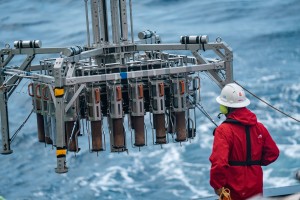It is well known that the oceans play an important role in regulating earth’s climate.
How?
Plant life such as algae living at the ocean surface absorb carbon dioxide (CO2) from the Earth’s atmosphere. These plants make use of the carbon in CO2 to build cells and grow while the oxygen is released to the oceans and back into the atmosphere. Carbon dioxide is a greenhouse gas, so absorbing CO2 and converting it into oceanic plant matter and oxygen is one of the ways the ‘oceans’ (or, rather, ocean life) help to combat climate change.
When plant matter is consumed by other marine life, the absorbed carbon is transferred with it. When these plants and animals die, the remains fall deeper in the ocean, decomposing along the way. As the decomposition occurs, the carbon becomes more processed and the quality and quantity of carbon decreases. The deeper the organic matter falls, the less carbon there is.
By the time this organic matter from decomposed plant and animal life reaches the deep ocean, there is not much carbon left. The carbon that does reach the deep sea can be sequestered (i.e., locked away) into sea floor sediments by microbes and other life. This locking away of carbon is a key reason why it is said that the deep sea plays an important role in the ecosystem function of carbon sequestration.

Multi-corer taking seafloor samples while preserving sediment layers and avoiding interaction with the water column
However, the deep sea is defined as any sea water that occurs below 200 meters depth. The shallower parts of the deep sea will play a bigger role in sequestering [locking away] carbon simply because more carbon will reach these parts while very little will reach the abyssal plains found at a water depth of 4000 to 6000 meters. The little carbon that reaches these depths will be highly processed but nevertheless it is mineralized (ie taken up) by microbes that live in the sediment. The average organic matter content of deep sea sediments is typically less than 0.5%.
So, while the ultra-deep seafloor can lock away the carbon that reaches it, the low quality and low quantity of carbon suggest that the effects of polymetallic nodule collection on the service of carbon sequestration will be negligible.
What happens to the carbon if deep sea sediment is disturbed?
Deep-sea sediments have very low carbon content because they are located under nutrient-poor waters. As a result, and because they are very deep (i.e. some 5 kilometers below the ocean’s surface), the risk of releasing carbon into the atmosphere from polymetallic nodule collection is likely to be small.
References
Impacts of deep-sea mining on microbial ecosystem services†, Orcutt et al., 2020

